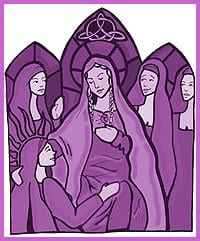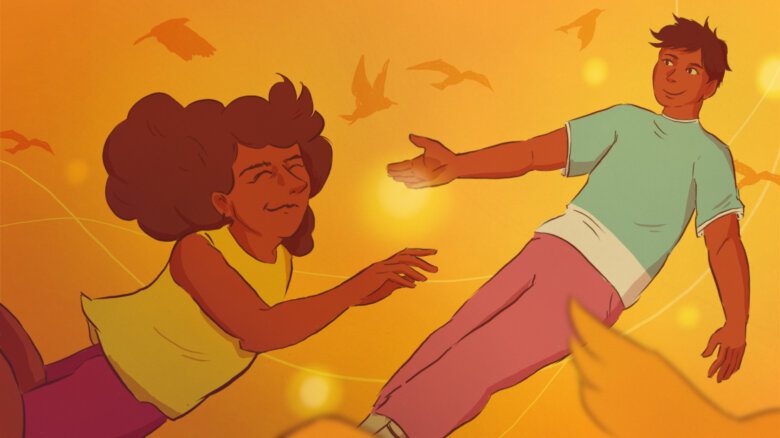On St Patrick’s day,Mar 17, Irish and non-Irish alike will be celebrating and partaking in Celtic culture. The green beer will be flowing, friendships will be struck up and renewed. There’ll be dancing and singing, storytelling and lots of love. Maybe even sex.
For centuries, Celtic culture has been renowned for drinking and storytelling, but it’s not exactly known for its eroticism. Even in traditional Irish dancing there is no close contact with your partner, and often not even eye contact.
But it wasn’t always like this. In ancient times, the Celts were renowned as much for their erotic energy and multiple love affairs as for their warlike habits. Male warriors were often part of sodalities, groups of “special friends,” who engaged freely and openly in same-sex relationships. Ancient Greeks such as Aristotle and Strabo mention Celtic homosexuality as one of the few good things about what they considered a barbarian culture.
Because Celtic women had the right to bear arms and to stand in the line of battle with men, they were closer to having legal equality than the women in most other cultures. Moreover, they had sexual autonomy. Under ancient Celtic law, marriages were made specifically for the purpose of procreation. The Romans were horrified by the existence of polyandrous and polygamous marriages among the Celts. Nonprocreative relationships outside of marriage were also acceptable and legal for men and women.
Although Greek and Roman historians do not mention woman-loving women in their observations of the Celts, it’s likely because most early histories were written by men, who often disregarded or simply didn’t notice lesbian activities. There is, however, one very intriguing exception, the most famous and important of Irish female saints, Brigid Of Kildare.
To understand her story, and how revolutionary it really is, some background is necessary.
While Ireland was still a pagan culture, Christianity was taking hold in Europe and North Africa. Christian philosophy was naturally affected by its contact with Classical culture that had, under the influence of Pythagoras and the Stoics, increasingly taught that all sexual relationships were physically harmful, and sexual abstention was the wisest course. During the fourth century of the Common Era, Saint Augustine and Saint Jerome were pushing Christianity toward their own view of sexual morality, which severed love from sex and equated any expression of sexuality with sin. For both of these fathers of the early Christian faith, virginity – or at least chastity – was the only path for a good and holy life.
Opposition to this viewpoint came from a Celt, a man named Morgan – better known as Pelagius, the heretic. (You may recall him as a sympathetic character in last summer’s movie King Arthur.) True to his Celtic heriage, Pelagius did not separate love and sex.His vision of human life did not include Original Sin, which Augustine claimed was transmitted from parents to children at birth. The struggle between Augustine’s ideas and Pelagius’ continued for decades, though in the end, officially, Augustine won.
Meanwhile, back in Ireland, Patrick began to preach around 435 CE. As Christianity began to take hold, the traditional varieties of Celtic marriage collapsed over the centuries until finally monogamy was the norm and all non-procreative sex was condemned.
But the tradition of “special friends” and the importance of love did not die out. It was an essential part of the culture. An old Celtic saying holds, “A person without a soul friend is like a body without a head.”
Though Irish monasteries in the Dark Ages between the years of 600 and 1200 CE tried to control the sexuality of their monks and nuns, the privileges of soul friendship could not be torn out. The old Celtic habit of men sucking on each other’s nipples to affirm friendship, particularly after a quarrel, was slow to change. Monastic books called Penitentials are filled with prescribed penalties for kissing, passionate kissing, interfemoral and anal intercourse between monks. Usually monks were instructed to fast for days or even years after such activities in the belief that a hungry man is a chaste man. It’s interesting to note that the penalties for monks indulging in sodomy were no harsher than for married couples engaging in the same.
And what of women? In Continental Europe, women’s lives were entirely circumscribed by men. But in Ireland, Brigid left the world of men for the hill of Kildare, where in Druid times sacred groves of oaks grew and a sacred flame had been kept burning. A group of women joined her. Their congregation lived entirely separate from men. Though later sources denied it, Brigid herself was ordained a priest by Bishop Mel, and made a bishop so that no man would have to enter her convent.
By all accounts, Brigid was a kind and generous woman. She is the patron saint of milkmaids in honour of a time when she milked her cows three times in one day to provide food for visitors.
Much of the life of Saint Brigid consists of stories that show the close connections between her and the Celtic goddess Brigid, the divinity of fire, childbirth and inspiration. Some of the stories of her magnanimity are clearly legends, as is the story of how, as a beautiful young woman, she had torn one of her eyes out of its socket to discourage a male suitor.
But one story recounted by the monks seems to hold a truth they could not see. Though monks and nuns were supposed to sleep alone, Brigid shared her bed with a young nun named Darlughdacha. The name means “daughter of the sun god” and is appropriate for the beloved of a goddess of fire.
Once, when Darlughdacha saw a warrior passing by, and looked after him with enthusiasm and a little lust, Brigid reacted like a jealous lover. With her powers as Darlughdacha’s superior and bishop, she appointed a penance for her friend: she filled Darlughdacha’s shoes with hot coals to punish and purify her. Later they resumed their relationship and, according to the story, lived happily ever after. Brigid, to make up for her anger and jealousy, granted her friend the right to succeed her as Abbess Of Kildare.
Brigid seems to have felt that abstaining from sexual contact with men was chastity enough for a good Christian woman. Her prayer is a good one for St Patrick’s Day – or any day.
“I should like a great lake of finest ale,
For the King Of Kings.
I should like a table of the choicest food,
For the family of heaven.
Let the ale be made from the fruits of faith,
And the food be forgiving love.”
* Gayle Gibson is a teacher at the Royal Ontario Museum and president of the Society For The Study Of Egyptian Antiquities.

 Why you can trust Xtra
Why you can trust Xtra


